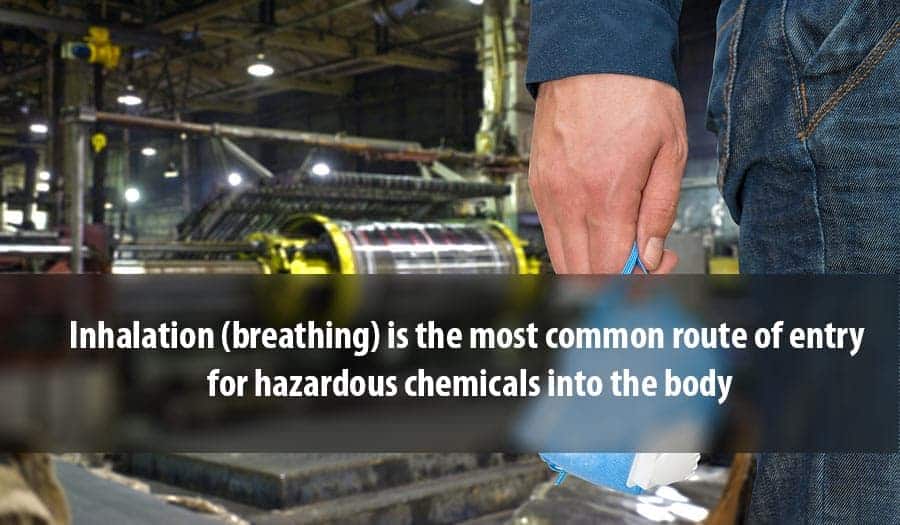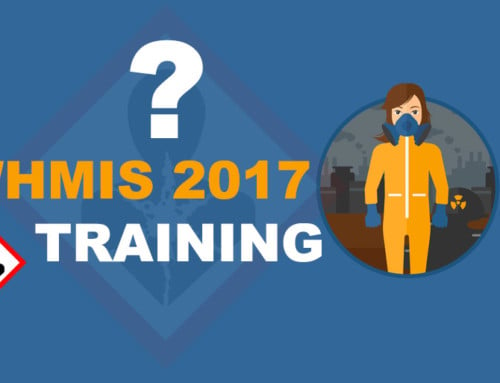WHMIS Routes of Entry
A large number of workplace chemicals can cause adverse effects when they come in contact with the human body. The nature and severity of the adverse effects depend on the toxicity of the chemicals as well as how the exposure occurred.
For example, the spillage of hydrochloric acid on the skin will result in immediate skin burn while sustained exposure to asbestos can result in lung cancer. Likewise, exposure to carbon tetrachloride may cause liver damage; exposure to some halogenated hydrocarbons may cause kidney damage while exposure to benzene or arsenic may induce cancer. The nature and severity of the adverse effects depend on the toxicity of the chemicals as well as how the exposure occurred.
The way in which chemicals can enter the human body are commonly referred to as the WHMIS routes of entry.
The Primary WHMIS Routes of Entry
According to WHMIS 2015, there are 4 major routes of exposure to hazardous chemicals. They Include:
Inhalation: Hazardous gases and airborne particles can enter the body when breathed in through the nose or mouth.
Absorption: Hazardous chemicals, such as vapors, mists, dust or smoke, can enter the body through the skin or eyes.
Ingestion: Hazardous chemicals can enter the digestive system when eaten or swallowed through the mouth.
Injection: Hazardous chemicals can enter the body through accidental puncture, cut or impact on the skin.
Inhalation (breathing) is the most common of the WHMIS routes of entry for hazardous chemicals into the body, but some chemicals also enter the body when absorbed through the skin. Less commonly, hazardous chemicals may be ingested (swallowed) after contaminating the hands, cigarettes or snacks. It is for this reason that workers should never drink, smoke or eat in areas where they can be exposed to toxic chemicals. The least common route of entry is injection. It occurs when a sharp object accidentally punctures the skin and inserts a chemical into the bloodstream or when a hazardous chemical is sprayed on the skin at very high pressure.

INHALATION
Inhalation is taking in hazardous chemicals into the body by breathing them in. The chemical contaminants are breathed in through the nose or mouth and reach the lungs. From the lungs, the chemical contaminants such as mists, dusts, fumes, gas and vapors are conveyed to the bloodstream and tissues.
So, how does inhalation of hazardous chemicals occur?
- Firstly, the air in the workplace is contaminated by the hazardous chemical in the form of vapors, mist, dust or fume.
- The worker breathes in contaminated air through the nose and/or mouth.
- Air breathed in via the nose is filtered by nasal hairs to remove large, solid contaminants. But because of the small bones and cartilages of the nose, the inhaled air will swirl around the nose and some large particles will be trapped in the mucus lining of the nose.
- Next, the air from the mouth and nose will pass through the back of the throat and will gain entry into the pharynx (the entrance to airways). The pharynx is divided into two: the trachea leading to the lungs and the esophagus leading to the stomach.
- The contaminated air will enter the trachea. The trachea is divided into two large branching tubes called bronchi. Each tube, called bronchus, enters one lung and then begins to divide into smaller and tinier tubes called the bronchioles.
- The bronchioles end in thin-walled air pouches called alveoli (singular-alveolus). Alveoli walls are supplied with blood capillaries which bring carbon dioxide from the body to the lungs for exhalation (breathing out) and collects contaminated air (oxygen) from the lungs for distribution throughout the body.
- Hazardous vapors, mists, fumes or gases that reach the alveoli will pass into the bloodstream and be distributed around the body, resulting in adverse effects.
Examples of hazardous chemicals that enter the body through inhalation include:
Vapors and Gases: When organic solvents such as methyl ethyl ketone (MEK), toluene or alcohols evaporate, they produce vapors which may contaminate the air in the workplace. Similarly, workplace chemicals that exist as gases under pressure may also diffuse in the workplace when their containers are opened.
Mists: Various industrial processes can produce tiny liquid droplets which float in air as mists. Usually, the mists form when liquids are broken up, splashed or atomized, but some also form when gases condense into tiny liquid droplets. Examples of workplace mists are paint spray mists formed during painting operations, oil mists formed during cutting and grinding, and acid mists formed during electroplating.
Dusts: Are tiny solid particles generated by abrasive or mechanical workplace activities. The solid particles are light enough to float in air, but they can also settle to the ground after a period of time, resulting in dusty surfaces.
Fumes: Fumes are extremely tiny solid particles produced when heated metals are evaporated in air and then cooled back to solid. They are commonly produced in welding operations and remain airborne, contaminating workplace air.
Smoke: Smoke is soot or carbon that is produced when organic chemicals or substances burn. The smoke particles may remain in the air long enough to contaminate workplace air, but can also settle down to form black coloration on equipment surfaces.
ABSORPTION
When hazardous chemicals come into direct contact with the skin or eyes, they can be absorbed into the body or may cause local effects on the area of contact. These chemicals may include solids (dusts and smoke), liquids, vapors and gases. Generally, however, most chemicals that are absorbed through the skin are liquids while gases and solids are only absorbed when they have first been dissolved in the moisture on the skin surface.
The absorption WHMIS route of entry is divided into skin contact and eye contact.
Skin Contact
Skin contact is one of the most significant routes of entry. The skin is divided into two main layers: the epidermis (thin outermost layer) and dermis (thicker underlayer). The epidermis has several layers tightly-packed cells which form a barrier against water, infectious agents and some chemicals. The outer layer of the epidermis (external part of the skin) is called the keratin layer. It resists the entry of water but is also composed of fat and fat-like substances which absorb fat, oil and grease. The keratin layer also resists weak acids, but is ineffective against organic and several inorganic chemicals.
Mechanisms of absorption of hazardous chemicals into the skin include:
- Caustic (alkaline) chemicals can soften keratin layer of the skin and pass through the epidermis into the dermis. In the dermis, they enter the veins and pass into the bloodstream.
- Detergents and organic solvents can cause dryness, cracking, hives, ulcerations or flaking of the skin, which weakens the protective skin layer and allow them to enter the body.
- Corrosive chemicals burn the skin and may allow the entry of infectious agents and other chemicals.
- Hairy areas of the body such as the forearms contain small ducts which can easily be penetrated by hazardous chemicals.
- Chemicals may also enter the body through scrapes, cuts or punctures on the skin.
Chemicals vary differently in their degree of penetration of the skin. For example, solvents like naphtha, trichloroethylene and toluene will soften the keratin layer and gain entry into the skin, but will not penetrate much further into the epidermis unless there is extended skin contact. On the contrary, hazardous chemicals such as carbon tetrachloride, benzene, methyl alcohol and carbon disulfide will readily pass through the epidermis and consequently enter the bloodstream.
Eye Contact
Even though eye contamination and eye splashes are fairly common in the workplace, large quantities of hazardous chemicals do not enter the body this way. In fact, any chemical, whether dust, mist, liquid, aerosol, gas or vapor can be in contact with and enter into the eye with or without gaining exposure to the bloodstream. For instance, toluene can enter into the eye and cause keratitis (inflammation of the outer layer of the eye), resulting into passage into the bloodstream. Generally, corrosive chemicals should be a primary concern as they will cause significant eye damage and will easily enter the body through the eye.

INGESTION
Ingestion (swallowing) refers to the entry of hazardous chemicals into the body through the mouth. At the workplace, chemical particles, mists and dusts can be ingested when they contaminate food, drinks, hands and cigarettes and then come into contact with the mouth, or when they are inhaled through the mouth, trapped in mucus and then swallowed. Drinks and food are often contaminated through contact with unwashed hands, clothing or gloves, or when left exposed in the workplace.
Exposure through inhalation involves the following stages:
- First, the contaminated chemical is swallowed or eaten.
- The chemical passes down the esophagus and then into the stomach.
- In the stomach, some chemicals like alcohols will cross the stomach wall and enter the veins and bloodstream. But majority will pass down to the small intestine.
- In the small intestine, several hazardous chemicals can be absorbed into the bloodstream through hundreds of small finger-like projections known as villi.
- Other chemicals, whose molecules are too big to pass through the villi or which are insoluble, will remain in the gut and be passed out through feces.
- Acidic, caustic and some organic chemicals may also cause severe “burns” as they pass through the digestive system, especially if they are ingested in large concentrations.
Examples of chemicals that enter the body through ingestion:
- Workplace dusts, fumes and smoke enter through accidental swallowing of contaminated mucus.
- Hazardous chemicals such as lead paint can be ingested from contaminated hands.
- Workplace liquids such as toluene may be accidentally ingested when mixture with drinks.
INJECTION
Injection is the least common WHMIS routes of entry. It may occur through accidents with broken glass, misuse of syringe needles or accidental pricks with sharp objects that have been contaminated with hazardous chemicals. Injections may also occur through streams of liquids and gases under high pressure. It is a common problem in hospitals and veterinary clinics where workers may accidentally puncture their skin with contaminated needles and other sharp devices.
General WHMIS 2015 Resources:
WHMIS 2015 Labels
WHMIS 2015 Hazard Classification
WHMIS 2015 Pictograms
WHMIS 2015 Safety Data Sheets
WHMIS 2015 Education & Training






